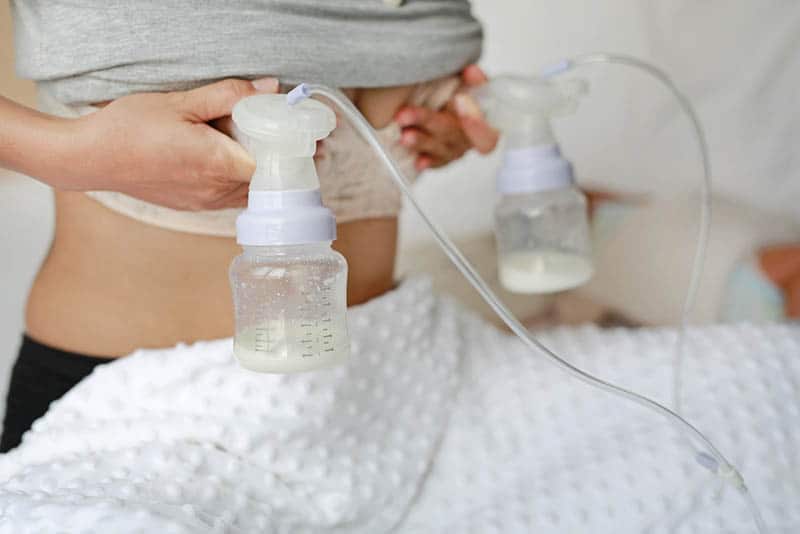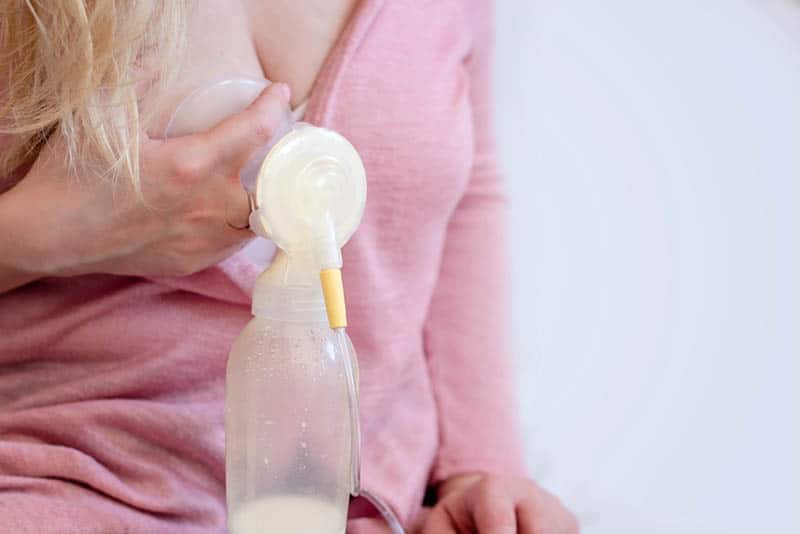It’s no secret that breastfeeding can be painful, especially in the beginning when you and your baby are still learning and adjusting to each other.
Even if you’re exclusively pumping, you might find that your nipples are a little too elastic for comfort.
Women who have elastic nipples may notice how the nipple stretches to the edge of the flange tunnel, causing pain, soreness, and even cracking. And even after a pumping session, the breasts still haven’t fully emptied.
The best position for the nipple inside the flange is somewhere in the middle of the tunnel so you can pump milk properly without all the extra pressure on your areola restricting the flow of milk.
If you happen to have a little extra elasticity in your nipples, there are 4 tips you can try to deal with the uncomfortable symptoms, including a pumping accessory known as a breast pump cushion.
And if you’re absolutely set on not buying any more pumping gear, I’ve got some easy solutions that don’t require you to swipe your credit card!
What Are Elastic Nipples?

The elasticity of the nipple can become an issue for women who are pumping breast milk.
While nipples are supposed to stretch somewhat while breastfeeding, some moms find that their nipples are a little too elastic.
A woman is considered to have elastic nipples when they stretch to the end of the flange. Under normal circumstances, your nipple should move just about halfway down the breast pump flange, not the whole way.
There are numerous symptoms that come with having elastic nipples. First of all, you’ll be able to see how far down the flange your nipple is and this can be accompanied by pain.
Beyond some initial discomfort, pumping shouldn’t be painful, so this is an immediate red flag that something is wrong.
Another symptom is slow milk flow and low milk production.
When too much of the nipple and areola is pulled into the flange, the pressure of the pump can restrict the flow of milk, so you’ll notice that your milk output is lower than it should be.
As any breastfeeding mom knows, breast milk production is very much a supply-and-demand kind of business.
So when your breasts aren’t being adequately emptied while pumping, your milk supply will be negatively affected.
Furthermore, you might have sore or even cracked nipples. When all of these symptoms are combined, throwing in the towel and buying a tub of baby formula might seem very appealing.
RELATED: Switching From Breast Milk To Formula: Step By Step Guide
But worry not! There are many solutions for having nipples that are a little too elastic.
Elastic Nipple Solutions
Here is a brief overview of solutions you can try for elastic nipples.
• Apply coconut oil to breast shields.
• Adjust the strength of the vacuum.
• Try a breast pump cushion.
• Look into purchasing a different flange size.
1. Apply coconut oil

Coconut oil is a common tip given to moms with too much elasticity in their nipples, partially because it can minimize the friction and pain during the pumping process.
If it gets in your milk, there’s no need to worry as it’s safe for babies. But make sure to purchase coconut oil that’s labeled as organic and unrefined.
After you’re done, clean out any residue from the flanges. Some moms also apply lanolin or even olive oil instead of coconut.
If you’re not comfortable applying anything to the inside of your breast shield, your own breast milk can do the trick! After hand-expressing a few drops, rub the milk on the inner part of the tunnel.
In case you are experiencing soreness or pain after a pumping session, allow a small amount of milk to dry on your nipples. According to La Leche League, your milk can actually heal the sore tissue!
2. Adjust the suction strength

Depending on the kind of pump you’re using, you should also make sure that the suction strength isn’t set too high.
For a comfortable pumping experience, be mindful of how much discomfort you can tolerate.
This means avoiding setting the suction strength to the maximum level if you can’t handle it.
Women with elastic breast tissue will also benefit from lowering the suction setting as it won’t apply too much pressure on the milk ducts, allowing the breasts to be fully drained.
3. Try a breast pump cushion

Some moms also find relief in a breast pump cushion, which is a kind of pumping accessory you place between your nipple and the flange to keep the nipple in place and customize the fit in case your flanges don’t fit you properly.
What’s more, they can make the breast pumping experience more comfortable because they act as a gentle barrier between the plastic of the flange and the sensitive tissue of your nipple – especially in cases of exclusive pumping.
While these cushions have been a game-changer for some moms, others have found them to be more trouble than they are worth.
So make sure to do your research before purchasing them for the first time.
Many moms with elastic breast tissue have found that BeauGen cushions can be of immense help when it comes to keeping their nipples positioned properly when pumping.
They’re also a great option if your flanges are the wrong size (or if you are between sizes) as they create a better fit.
Unfortunately, these cushions do need to be replaced every couple of weeks.
The exact lifespan of each pair will depend on how much you pump. What’s more, they cannot be sterilized, as the material can get damaged when exposed to very high temperatures.
4. Change the flange size

Finally, when it comes to flanges, you can look into purchasing a larger or smaller size.
For instance, if your current flanges are too large, the suction of the pump will only pull your nipples further in.
But if it’s too small, there will be too much friction, causing pain and discomfort.
In addition, moms with small nipples may have a hard time finding flanges that are a good fit.
Fortunately, there are companies such as Maymom that offer flanges for women whose nipple diameter is as small as 12 to 14 mm.
And remember, nipple size can change! If you’re not sure whether you’ve measured correctly, an international board-certified lactation consultant (IBCLC) can help you.
There are also companies making special flanges for women with elastic breast tissue, such as Pumpin Pals.
Some of their flanges are made from silicone that forces the nipple to stay in one place and prevents it from getting pulled down further into the flange.
They also don’t have a plastic ring that can make pumping uncomfortable.
Pumpin Pals flanges are available for a variety of breast pumps, including Medela, Spectra, and Lansinoh.
Another company that makes flanges for pain-free pumping is LacTeck. Their BabyMotion flanges are designed to imitate the feel of a baby nursing.
When you attach it to your breast, for example, the flange will gently compress your areola and nipple to encourage letdown.
Moms who pump also find these flanges to be super comfortable and most importantly, they’re able to pump more milk in a shorter period of time!
The LacTeck flanges are compatible with Hygia, Lansinoh, and Medela. With some maneuvering, they can also be used with Freemie cups and the Willow pump.
How To Measure Your Nipple Size

If you’re a first-time mom about to start your breastfeeding journey with the help of a pump, measuring your nipple will help you purchase the right flange size and get pumping off to a good start.
Because your size will probably change over time, it’s important to remeasure every once in a while to avoid pain or a low milk supply.
For example, most women find that their size changes around 10 weeks postpartum.
All you need is a measuring tape (a ruler will work, too) that you will hold up in front of your nipple to measure its diameter (the length across the middle). You don’t need to measure your areola.
Record the measurement in millimeters as most breast shields are labeled in this way.
Unless otherwise specified by the particular brand, it’s best to pick flanges that are 3 to 4 mm longer than the diameter of your nipple.
Another important thing to keep in mind is to measure both nipples as they might not be the same.
Likewise, it’s not recommended to measure your nipples while you’re still pregnant.
You’ll know that your flanges are the wrong fit if you experience any of the following:
• Your areola and nipple become white during or after pumping;
• Your breasts don’t feel empty after a pumping session;
• Pain in your nipples;
• Blocked milk ducts;
• Your nipples are uncomfortably chafing against the inside of the flanges;
• A big part of the areola is sucked into the flange.
Tips For Successful Pumping

Whether you are exclusively pumping or combining it with nursing your baby, pumping can be more complex than it seems.
All those pump parts and accessories can give any new mom a headache!
On the other hand, pumping is a terrific way to continue providing your little one with the best possible nutrition, while having the freedom to go out without worrying that your baby will go hungry.
Plus, this allows your partner to feed the baby, which is a fantastic opportunity to bond.
Here’s a quick overview of easy tips for successful pumping.
• Buy a good quality pump (preferably electric and manual).
• Find a quiet spot where you can relax and focus on pumping.
• Place a warm compress on your breasts if needed.
• Pump as often as you can.
• If you’re supplementing with formula, keep it to a minimum.
• Nurse on demand (unless you’re exclusively pumping).
• Eat healthily.
The first step is to do your research and find a good quality breast pump that will do its job well without causing you pain and making you regret the money you’ve spent on it.
And the good news is, if you live in the US, you might be eligible to get one free.
You’ll probably get an electric pump, but don’t forget about investing in a manual one as well.
They’re quite affordable and great to have on hand in case your electric pump breaks or if you’re traveling and can take it with you, for example.
To encourage letdown, especially when your baby isn’t around, it’s important to relax and find a quiet spot where you can think about your baby.
You can bring some baby clothes with you or a blanket that smells like your little one.
Put a warm compress on your breasts if you’re struggling with letdown.
If your maternity leave is up and you are back at work, try to pump as often as possible. Ideally, you’d be able to pump 3 times during an 8-hour workday.
Obviously, this depends on your baby’s age and other factors.
Make sure to talk to your employer about your plans to pump at work and how they can accommodate that during your work hours.
Sometimes, feeding your baby both formula and breast milk is inevitable, despite your best efforts.
That’s perfectly normal and you shouldn’t be feeling any mommy guilt! However, try to limit how much formula your baby drinks because it has a direct effect on your supply.
Like I’ve already said, breastfeeding is a supply-and-demand business – when you replace one of your baby’s meals with formula, your breasts automatically start producing less milk.
Unless you are exclusively pumping, try to nurse on demand when you’re at home.
When you nurse more often, you’ll see that your milk production will improve and pumping will be easier.
Like always, stay on top of your nutrition, which means eating good food, drinking plenty of water, and avoiding unhealthy habits such as smoking.
If you find that your milk supply has hit a slump, you can try galactagogues such as fenugreek to improve your production.
To Wrap Up
Without a doubt, there are some things you pay no attention to before you have a baby – the elasticity of your nipples being one of them!
And although all nipples are elastic to an extent, some women find that theirs are simply too elastic, making pumping difficult and painful.
When it comes to solutions for elastic nipples, sometimes all it takes is a bit of coconut oil (or your own breast milk) or adjusting the suction settings on your pump.
Pumping shouldn’t be painful and don’t push yourself to endure suction at the highest setting if it’s hurting.
Lastly, a new pair of flanges that fit you well or even a cushion that will create a better fit for your flanges can be a real lifesaver in such situations.
Don’t forget to remeasure your nipples every couple of weeks as well.
I hope you were able to find a solution that works for you and that you’ll soon be pumping without a fuss!
References:
• La Leche League International. (n.d.) “Breastfeeding with Sore Nipples”. Retrieved from La Leche League International website.
Like this post? Please share or pin it for later. You can also stay in the loop and follow us on Facebook, Instagram and Pinterest.

This post contains affiliate links. Please see our full disclosure or more info.

